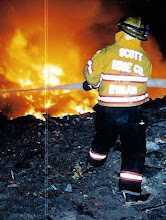Jumping from a burning building has long been, and remains, the last resort of a desperate victim, usually with less than optimum results. But on November 10, 1904, two girls jumped from an overcrowded fire escape platform, and this time things were different. They were caught by New York City firefighters using an unusual circular fabric device, a safety net. Now more recognized in comedic videos and seen in museums, the Browder Safety Net was at one time a common piece of equipment for ladder companies. Developed by a Civil War veteran by the name of Thomas F. Browder in 1887; he continued to evolve and improve the design, adding additional patents in 1900.
There were other successes, including one in 1901 in New York City in which twenty people reportedly leaped to safety. Failures, though, were common as well. In Newark in 1910, four women jumped simultaneously from an upper floor of a factory and tore through the net. Although two deployed nets saved a few, a similar situation occurred at the infamous Triangle Shirtwaist factory fire and many more jumpers were missed. Additional stories on other fires abound of individual victims who jumped, but missed the net or hit the edge, sometimes injuring firefighters.
Ladder trucks carried the net folded and typically mounted vertically on the side of the apparatus. It could be deployed in seconds, but required at least ten or more firefighters holding it at shoulder height, in the right place and time. With the fabric center and springs connecting it to the circular frame, it was a portable man held version of the circus trampoline, but with less bounce.
The ideal way in which to jump was with the legs straight out in a seated-like position, and arms crossed in front of the torso with the objective being to land on the small of the back or buttocks. While a firefighter could easily be taught this during a routine training session, a victim at a fourth floor window with smoke pouring from around them or flames nipping at their heels would not be a receptive student. The firefighters on the ground would catch them, or try to, in any orientation in which they jumped.
As time passed and the length of aerial ladders increased, the need for the Browder net decreased. Concerns over its safety and effectiveness grew and in the 1950s departments began to phase out their use. These nets are now little more than a curiosity, displayed in museums, fire stations, and at least one firefighter’s home bar. If keeping a fire scene from being a “circus” is a good thing, no longer bringing our own trampoline probably helps.













